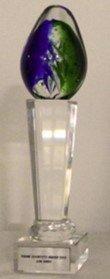Prof. Dr. Dr. Lerche, Chairman of the Scientific Committee and LUM Managing Director: “Since 2014, we have been advertising the Young Scientist Award (YSA) for outstanding scientific achievements in the areas of particle and dispersion characterization as well as material testing and awarding it at the conference according to defined quality criteria. Young scientists from Germany, France, India, Norway and the Czech Republic answered the call and applied for the prize. Three finalists from Europe and India were ultimately nominated by the jury for 2024. They are expected to attend the conference with their interesting results upon invitation. Completely independent of the selection procedure, the overarching theme of particle surface properties and their characterization is excitingly visible in all nominated applications, a trend that we are increasingly encountering in our own scientific work and with our customers.”
Amin Said Amin, Institute for Energy and Materials Processes – Particle Science and Technology (EMPI-PST), University of Duisburg-Essen (UDE), Duisburg, Germany, was nominated for his work entitled: Developing a Methodology for Systematic Selection of Probe Liquids to Determine Hansen Solubility Parameters for Carbon Black materials. Hansen solubility parameters (HSP or Hansen dispersibility parameters, HDP) are particularly relevant when it comes to the dispersion of particles in liquids; they characterize the surface properties of nanoparticles. HDPs can provide an understanding of key factors in the development and design of electrodes, electrolytes and other key components of electrochemical systems. Current methods for determining HDP of nanoparticles by sedimentation are based on the use of a variety of liquids with different HSP. These experiments are time-consuming and partly harmful to the environment and associated with potential health risks. In response to this challenge, Amin and his team developed a two-stage strategy that allows for a systematic selection of fewer liquids. The analytical multi-sample centrifuge LUMiSizer® is used for these investigations.
Théo Merland, Institute for Molecules and Materials of Le Mans and Soft Matter Sciences and Engineering, ESPCI Paris-Sorbonne University, France, has successfully submitted an application describing his work on aqueous fullerene suspensions. Buckminster fullerene (C60) is an attractive molecule due to its high conjugation, with applications in (electro)-optical and biomedical fields. In many applications, its use requires processing in an aqueous medium. However, since fullerene is highly hydrophobic, it can only be dispersed in water at ppm levels. Merland and his team developed two different processes to disperse large amounts of fullerene in water: the Ouzo effect, in which fullerene is first dissolved in a water-miscible organic solvent, and emulsion evaporation, in which a water-immiscible solvent is used. The LUMiSizer is used here to determine the particle size distribution of the nanoplates, some of which are larger than the upper detection limit of the light scattering method. Furthermore, the separation stability of the fullerene suspensions was characterized using the same device.
Priyabrata Sahoo, Center for Nano and Soft Matter Sciences, Bengaluru, and Manipal Academy of Higher Education, Manipal, India became a finalist for his scientific achievements under the theme Interfacial Properties Dominate over Bulk Solvent Properties in Liquid Phase Exfoliation: an Experimental Study using Dispersion Analyser summarized.
Liquid Phase Exfoliation (LPE) is one of the most successful techniques to obtain two-dimensional (2D) materials such as graphene, boron nitride, MXene, etc. and utilize their exotic properties in various applications. Although LPE is a simple and scalable process, the peeling mechanism is quite complex and has not been studied in detail in the literature. The goal of Sahoo and his team’s work was to understand the role of the solute-solvent interface in LPE of 2D materials and dispersion stabilization. A dispersion analyser (LUMiSizer) was used to understand the peeling efficiency and stability of the dispersions obtained in different solvents.
Get in touch with the finalists at the conference; you are cordially invited to Berlin.
Conference registration and details:
https://conference2024.lum-gmbh.com/
LUM Young Scientist Awards 2014-2024, review and outlook: https://www.youtube.com/watch?v=4JFF1TZkY0M
Conference abstracts: https://www.dispersion-letters.com/
All talks:
https://www.lum-gmbh.com/files/Presse/Presse_2024/ICDAMT2024_web.pdf
LUM GmbH
Justus-von-Liebig-Str. 3
12489 Berlin
Telefon: +49 (30) 6780-6030
Telefax: +49 (30) 6780-6058
http://www.lum-gmbh.com
Marketingleiter
Telefon: +49 (30) 678060-40
Fax: +49 (40) 678060-58
E-Mail: A.Uhl@lum-gmbh.de
![]()
